
by Judith Goodstein
California Institute of Technology
The California Institute of Technology is a small, independent university of research and teaching in science and engineering, with 900 Ph.D. level researchers, including almost 300 regular faculty, 900 undergraduates, and 1,000 graduate students. In spite of its small size, it has become one of the world’s leading institutions of scientific research and education.
Caltech’s beginnings are rooted in a modest little college founded in Pasadena in 1891 by wealthy former abolitionist and Chicago politician Amos Throop. Initially named Throop University, the school changed its name to Throop Polytechnic Institute in 1893. In its first fifteen years, Throop served the local community, teaching a great variety of subjects, from arts and crafts to zoology, with considerable emphasis on vocational training. By 1906, Throop needed a fresh sense of purpose. The American astronomer George Ellery Hale, the first director of the nearby Mount Wilson Observatory and a newcomer to Pasadena, would provide it.
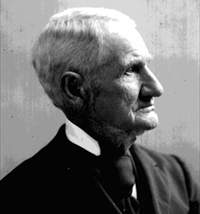
Amos Throop
Courtesy of the Archives, California Institute of Technology
A scientist bubbling over with educational, architectural, and civic ideas, Hale was elected to the school’s board of trustees in 1907 and promptly set about to transform it. He persuaded school officials to abandon Throop’s high school and other programs and concentrate on expanding and developing the college along engineering lines; recruited James A. B. Scherer, who served as Throop’s president between 1908 and 1920; and enticed Arthur A. Noyes, former president of MIT and the nation’s leading physical chemist, to join him in Pasadena. In Noyes, Hale saw not only an opportunity to bring chemistry at Throop College (Throop officially changed its name to Throop College of Technology in 1913) up to a level with that at MIT but also to put Throop itself in the national limelight. The third member of Hale’s scientific troika was the physicist Robert A. Millikan who began, in 1917, to spend several months a year at Throop as director of physical research.
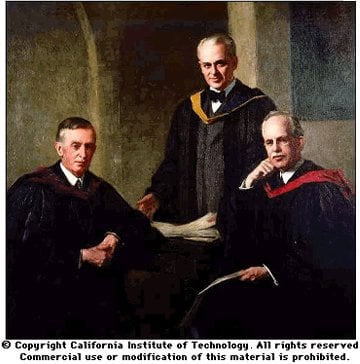
Portrait of Noyes, Millikan, Hale hangs in the main dining room at the Athenaeum.
Color photo by Robert Paz. Courtesy of the Archives, California Institute of Technology
The three of them spent the World War I years in Washington, organizing and recruiting scientists to work on military problems, but also building a superb network of contacts that would later serve the school well. Collectively ambitious for American science, eager to see their country play a larger role on the world’s scientific stage, and determined to put Throop on the map, Hale, Millikan, and Noyes had become a formidable scientific triumvirate by 1918. By Armistice Day, they had set the stage to transform the engineering school into an institution that put pure science first.
Between 1919 and 1921, the school obtained a handsome endowment, drafted a new educational philosophy, took its present name, and selected a new man to guide its destiny for the next twenty-five years. Hale and Noyes wanted to use Caltech to reshape the education of scientists. Millikan wanted to make Caltech one of the physics capitals of the world. To do that, he needed research funds. The three men came to an agreement. Hale and Noyes promised Millikan the lion’s share of the school’s financial resources and minimal administrative duties as head of the Institute. In return, Millikan agreed to come, as director of the Norman Bridge Laboratory of Physics, and administrative head of the Institute. By then, Noyes had resigned from MIT and accepted a full-time appointment as director of chemical research in Pasadena.
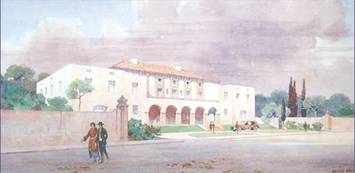
In the early 1920s, Caltech was essentially an undergraduate and graduate school in the physical sciences. Indeed, until 1925, the institution offered graduate work leading to the doctorate only in physics, chemistry, and engineering. Geology joined the list of graduate studies in 1925, aeronautics in 1926; biology and mathematics in 1928. Physics was king from the very beginning. It had more students, more faculty, and more money than other departments had. Millikan initiated a visiting-scholars program shortly after his arrival in Pasadena. The list of scientists who accepted Millikan’s invitation represented the cream of European physics, including Paul Dirac, Erwin Schrödinger, Werner Heisenberg, Hendrik Lorentz, and Niels Bohr. Albert Einstein‘s visits to the campus in 1931, 1932, and 1933 capped Millikan’s plans to put physics on the map in southern California. If nothing else, Einstein’s visits showed dramatically that the Caltech that Hale, Millikan, and Noyes had set out to build in the twenties had come of age in the thirties.
Millikan, who functioned as the school’s president between the wars, was fiercely opposed to government funding of research. He relied on the major private foundations, especially the Rockefeller and the Carnegie, and a growing number of southern California philanthropists to provide the funds he needed. He believed that the modern world was basically a scientific invention, that science was the mainspring of the twentieth century, and that America’s future rested on the promoting of basic science and its applications. Caltech, in Millikan’s view, existed to provide America’s scientific leadership.
 |
| Photo taken at March Field during JATO experiments with the Ercoupe airplane by USAF. Rockets developed by CIT/JPL. From left: C.B. Millikan, M. Summerfield, T. von Kármán, F.Malina and Capt. H.A. Boushey Date: August 1941 Courtesy of the Archives, California Institute of Technology |
The focus of scientific research at the Institute under Millikan during the 1930s ranged from Drosophila genetics and the biochemistry of vitamins in biology, to the theory of turbulence and airplane wing design in aeronautics; from cancer therapy with radiation and the radioactivity of the light elements in nuclear physics, to soil erosion and the transmission of water from the Colorado River to Los Angeles in engineering; from the application of quantum mechanics to molecular structure in chemistry, to the introduction of the magnitude scale in seismology.
An educational institution in name only during the war, Caltech had a war arsenal that included rockets, proximity fuses, the Jet Propulsion Laboratory, and $80 million in federal funds for war-related research and development.
Caltech’s history is divided into two distinct eras. The first Caltech era was created by Hale, Millikan, and Noyes. Thirty years later, after World War II, the physicists Lee Alvin DuBridge and Robert Bacher did the job all over again. DuBridge, the head of MIT’s wartime radar project, became Caltech’s new president in 1946. Bacher, the leader of the Los Alamos atomic bomb project’s “G” Division (the “G” stood for gadgets), arrived in 1949 to head up the division of physics, mathematics, and astronomy and later became the Institute’s first provost.
During DuBridge’s tenure (1946-1969), Caltech’s teaching faculty doubled in number, the campus tripled in size, and new research fields blossomed, including chemical biology, planetary science, nuclear astrophysics, and geochemistry. 1948 saw the dedication of a new 200-inch telescope on Palomar Mountain, the world’s most powerful optical telescope for more than forty years. Unlike Millikan, DuBridge argued that the federal government had a responsibility to support scientific research.
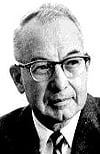
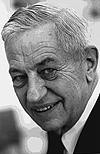
Robert Bacher and Lee Alvin DuBridge
Courtesy of the Archives, California Institute of Technology
As Caltech’s new physics head, Bacher rebuilt the physics department, and he did so with a vengeance, starting with high-energy particle physics. Then a new field, particle physics hardly existed at Caltech in 1949, except for the work of Carl Anderson and his students, including Donald Glaser, a later Nobel-Prize winner, who used cosmic rays from space as a natural source of high-energy particles to do particle physics. While chairman, Bacher initiated construction and use of a new electron accelerator, so that the Caltech group could make its own high-energy particles. The Institute closed down its electron synchrotron in 1969, shortly after ground was broken for the national accelerator laboratory–Fermilab, in Batavia, Illinois. Theoretical physics, always a stepchild under Millikan, entered a golden age with the acquisition of Richard Feynman and Murray Gell-Mann. Feynman, then at Cornell, was Bacher’s first acquisition.
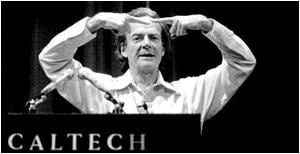 |
| Richard Feynman lecturing. Courtesy of the Archives, California Institute of Technology |
Historical studies of the development of Caltech as a research university after the war are scarce. There are no biographies of key figures from George Beadle, Charles Richter, and William Fowler onwards.
Bibliography
Ajzenberg-Selove, Fay. “A Matter of Choices: Memoirs of a Female Physicist.” New Brunswick: Rutgers University Press, 1994.
Florence, Ronald. “The Perfect Machine: Building the Palomar Telescope.” New York: HarperCollins, 1994.
Geiger, Roger L. “Research and Relevant Knowledge: American Research Universities since World War II.” New York: Oxford University Press, 1993.
Goodstein, Judith R. “Millikan’s School: A History of the California Institute of Technology.” New York: Norton, 1991.
Gorn, Michael H. “The Universal Man: Theodore von Karman’s Life in Aeronautics.” Washington, D.C.: Smithsonian Institution Press, 1992.
Kargon, Robert. “The Rise of Robert Millikan: Portrait of a Life in American Science.” Ithaca: Cornell University Press, 1982.
Kevles, Daniel J. “The Physicists: The History of a Scientific Community in Modern America (1978).” Paperback reprint, with a new preface, Cambridge, Mass.: Harvard University Press, 1995.
Murray, Bruce C. “Journey into Space: The First Three Decades of Space Exploration.” New York: Norton, 1989.
Reingold, Nathan. “Science and Government in the United States since 1945.” History of Science 32 (1994):361-386.
Servos, John W. “Physical Chemistry from Ostwald to Pauling: The Making of a Science in America.” Princeton: Princeton University Press, 1990.
Sinsheimer, Robert. “The Strands of a Life: The Science of DNA and the Art of Education.” Berkeley: University of California Press, 1994.
First published 29 June 1998